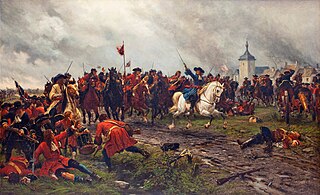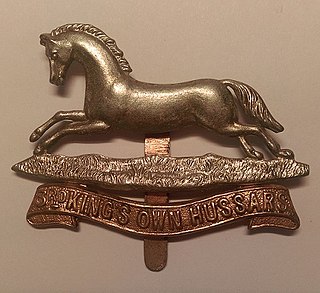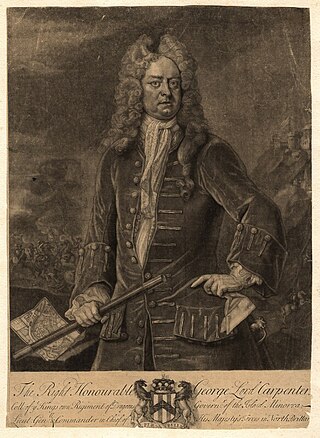
The Battle of Landen, also known as Battle of Neerwinden took place on 29 July 1693, during the Nine Years' War near Landen, then in the Spanish Netherlands, now part of Belgium. A French army under Marshal Luxembourg defeated an Allied force led by William III.

Lieutenant-General William Cadogan, 1st Earl Cadogan, was a British Army officer, diplomat, politician and peer. He began his active military service during the Williamite War in Ireland in 1689 and ended it with the suppression of the 1715 Jacobite Rebellion. A close associate and confidant of the Duke of Marlborough, he was also a diplomat and Whig politician who sat in the English and British House of Commons from 1705 until 1716, when he was raised to the peerage as Baron Cadogan.

The siege of Derry in 1689 was the first major event in the Williamite War in Ireland. The siege was preceded by an attempt against the town by Jacobite forces on 7 December 1688 that was foiled when 13 apprentices shut the gates. This was an act of rebellion against James II.

The Williamite War in Ireland took place from March 1689 to October 1691. Fought by Jacobite supporters of James II and his successor, William III, it resulted in a Williamite victory. It is generally viewed as a related conflict of the 1688 to 1697 Nine Years' War.

Major-General John Armstrong was a British military engineer and soldier, who served as Chief Royal Engineer and Surveyor-General of the Ordnance.

Limerick, a city in western Ireland, was besieged twice in the Williamite War in Ireland in 1689–1691. On the first occasion, in August to September 1690, its Jacobite defenders retreated to the city after their defeat at the Battle of the Boyne. The Williamites, under William III, tried to take Limerick by storm but were driven off and had to retire into their winter quarters.

The Siege of Namur, 25 May–30 June 1692, was a major engagement of the Nine Years' War, and was part of the French grand plan to defeat the forces of the Grand Alliance and bring a swift conclusion to the war. Namur, sitting on the confluence of the Meuse and Sambre rivers, was a considerable fortress, and was a significant political and military asset. French forces, guided by Vauban, forced the town's surrender on 5 June, but the citadel, staunchly defended by Menno van Coehoorn, managed to hold on until 30 June before capitulating, bringing an end to the 36-day siege. Concerned that King William III planned to recapture the stronghold, King Louis XIV subsequently ordered his commander-in-chief, the duc de Luxembourg, to join battle with the Allies in the field, resulting in the bloody Battle of Steenkerque on 3 August.
Charles Chalmot de Saint-Ruhe was a French cavalry officer, serving in the armies of Louis XIV.

The 3rd Hussars was a cavalry regiment of the British Army, first raised in 1685. It saw service for three centuries, including the First and the Second World Wars, before being amalgamated with the 7th Queen's Own Hussars, to form the Queen's Own Hussars in November 1958.

Lieutenant-General George Carpenter, 1st Baron Carpenter was a British Army officer, Whig politician and peer. He served as Commander-in-Chief, Scotland from 1716 to 1724 and as a member of parliament from 1715 to 1727.

The French Royal Army was the principal land force of the Kingdom of France. It served the Bourbon dynasty from the reign of Louis XIV in the mid-17th century to that of Charles X in the 19th, with an interlude from 1792 to 1814 and another during the Hundred Days in 1815. It was permanently dissolved following the July Revolution in 1830. The French Royal Army became a model for the new regimental system that was to be imitated throughout Europe from the mid-17th century onward. It was regarded as Europe's greatest military force for much of its existence.

The siege of Carrickfergus took place in August 1689 when a force of Williamite troops under Marshal Schomberg landed and laid siege to the Jacobite garrison of Carrickfergus in Ireland. After a week the Jacobites surrendered, and were allowed to march out with the honours of war.
Solomon Richards was a professional soldier who fought in Ireland first for Cromwell and then for William of Orange. He is best known for his part in a failed attempt to relieve the Siege of Derry in 1689.

Michael Richards (1673–1721) was an Irish military engineer who rose to become Chief Engineer of Great Britain and Surveyor-General of the Ordnance.

The Capture of Waterford took place in July 1690 during the Williamite War in Ireland when a force under the command of Percy Kirke captured the town of Waterford from its Jacobite Irish Army garrison. Full control of the town was not secured until Duncannon Fort across Waterford Harbour was also taken from its garrison under Michael Burke shortly afterwards. In both cases the garrisons were allowed to march out under escort to Jacobite-held Mallow in County Cork, but were denied the "honours of war" which they demanded.

William Dorrington was an English army officer. Contemporary sources often spell his surname as "Dorington", or "Dodington".
Dominic Sheldon, often written as Dominick Sheldon, was an English soldier. A leading Jacobite he served in James II's Irish Army during the Williamite War between 1689 and 1691. He was a noted cavalry commander, present at the Battle of the Boyne and Battle of Aughrim. Later after going into exile, he rose to the rank of lieutenant general in the French Army. He was also remained a prominent courtier at the Jacobite court in exile at Saint Germain.
Jacob Richards was an Irish officer of the English Army, He is noted for his innovations and influence on the development of British Artillery. Elements of his career are sometimes confused with his identically named father Jacob Richards. His two younger brothers Michael Richards and John Richards were both noted artillery officers.
John Richards (1669–1709) was an Irish soldier and artillery commander. He served in the Portuguese Army during the War of the Spanish Succession and was killed when a mine was detonated by the enemy while in command of the defence at the Siege of Alicante.
Christian Lilly was a German military engineer.